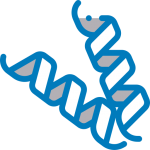
 HCMV Glycoprotein B (gB) Protein, His Tag
HCMV Glycoprotein B (gB) Protein, His Tag
CMB-V52H3
500ug
Brand
ACROBiosystems
Description
Source :
HCMV Glycoprotein B (gB), His Tag (CMB-V52H3) Val 23 – Lys 700, Arg 777 – Val 907 (Accession # P13201-1) with furin cleavage site mutated from ‘RTKR’ to ‘TTQT’, was produced in human 293 cells (HEK293) at ACROBiosystems.
Molecule : Glycoprotein B / gB
Synonyms : Glycoprotein B,gB,Envelope glycoprotein B
Format : Powder
Category : Viral Proteins
Accession : N/A
Storage : -20℃
Shipping condition : Powder,RT
Molecular Weight : 93.7 kDa
Characteristics :
This protein carries a polyhistidine tag at the C-terminus. The protein has a calculated MW of 93.7 kDa. The protein migrates as 116-130 kDa under reducing (R) condition (SDS-PAGE) due to glycosylation.
Endotoxin Level : Less than 1.0 EU per μg by the LAL method.
Buffer : PBS, pH7.4
Description :
Human cytomegalovirus is a species of the Cytomegalovirus genus of viruses, which in turn is a member of the viral family known as Herpesviridae or herpesviruses. It is typically abbreviated as HCMV or, commonly but more ambiguously, as CMV. CMV Virus Envelope Glycoportein B (CMV-GB) can be cleaved into glycoprotein GP55. Envelope glycoprotein that plays a role in host cell entry, cell to-cell virus transmission, and fusion of infected cells. CMV-GB may be involved in the initial attachment via binding to heparan sulfate together with the gM/gN complex that binds heparin with higher affinity. Furthermore, CMV-GB can interact with host integrin ITGB1, PDGFRA and EGFR that likely serve as postattachment entry receptors. Also, CMV-GB participates in the fusion of viral and cellular membranes leading to virus entry into the host cell. Membrane fusion is mediated by the fusion machinery composed at least of gB and the heterodimer gH/gL.
References :
(1) Wang X., et al., 2002, Nature 424:456-461.
(2) Feire A.L., et al., 2009, J. Virol. 84:10026-10037.
(3) Halary F., et al., 2001, Immunity 17:653-664.
Application
Reactivity



